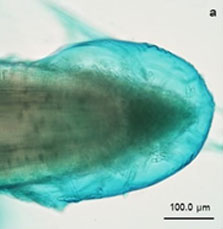การผลิตเซลล์บอร์เดอร์ของรากข้าวจาปอนิกา (Oryza sativa ssp. japonica)
คำสำคัญ:
ข้าว, เซลล์บอร์เดอร์ของราก, สารเมือกบทคัดย่อ
เซลล์บอร์เดอร์ของราก (root border cells, RBCs) เป็นเซลล์ที่ทำหน้าที่หลั่งสารที่ช่วยปกป้องปลายรากและส่งเสริมการเจริญเติบโตของพืช การผลิต RBCs มีความแตกต่างกันในพืชแต่ละชนิด เนื่องจากข้าวเป็นพืชอาหารที่มีความหลากหลายทางพันธุกรรมมาก จึงน่าสนใจที่จะศึกษา RBCs ในข้าว Oryza sativa ssp. japonica เพื่อเปรียบเทียบกับข้าว ssp. indica ที่มีการรายงานก่อนหน้านี้เกี่ยวกับบทบาทของ RBCs ในการทนเค็มทำการศึกษาโดยเพาะเมล็ดในสภาวะปลอดเชื้อจนได้รากที่มีความยาวต่าง ๆ กัน นำมาเตรียมเซลล์แขวนลอย RBCs ด้วยการชะปลายรากในน้ำกลั่น จากการนับเซลล์ภายใต้กล้องจุลทรรศน์ พบว่า มีการผลิต RBCs มาก (3,813±750 เซลล์) ตั้งแต่เมื่อรากมีความยาว 0.5 เซนติเมตร จำนวน RBCs คงระดับในปริมาณมากในช่วงความยาวราก 0.3–3.2 เซนติเมตร และมีแนวโน้มลดลงเมื่อรากมีความยาวเพิ่มขึ้น การจำแนกกลุ่มของ RBCs ตามสัดส่วนได้เป็น 3 กลุ่ม จากการเปรียบเทียบกับข้าว ssp. indica พบว่า RBCs ของข้าว ssp. japonica มีขนาดเล็กกว่าและมีความหนาของชั้นสารเมือกบางกว่าอย่างชัดเจน ผลการศึกษาทำให้เห็นถึงปัจจัยด้านความแตกต่างทางพันธุกรรมที่มีต่อลักษณะของ RBCs ในข้าว ซึ่งสนับสนุนแนวทางในการใช้ RBCs เป็นเครื่องมือศึกษากลไกการตอบสนองระดับเซลล์ต่อสัญญาณสิ่งแวดล้อมต่าง ๆ
เอกสารอ้างอิง
Cai, M.Z., F.M. Wang, R.F. Li, S.N. Zhang, N. Wang and G.D. Xu. 2011a. Response and tolerance of root border cells to aluminum toxicity in soybean seedlings. Journal of Inorganic Biochemistry 105: 966–971.
Cai, M.Z., S.N. Zhang, C.H. Xing, F.M. Wang, W. Ning and Z. Lei. 2011b. Developmental characteristics and aluminum resistance of root border cells in rice seedlings. Plant Science 180: 702–708.
Driouich, A., A. Gaudry, B. Pawlak and J.P. Moore. 2021. Root cap–derived cells and mucilage: A protective network at the root tip. Protoplasma 258: 1179–1185.
Ghanem, E.M., R.M Han, B. Classen, J. Quetin-Leclerq, G. Mahy, C.J. Ruan, P. Qin, F. Pérez-Alfocea and S. Lutts. 2010. Mucilage and polysaccharides in the halophyte plant species Kosteletzkya virginica:Localization and composition in relation to salt stress. Journal of plant physiology 167: 382–392.
Hamamoto, L., M.C. Hawes and T.L. Rost. 2006. The production and release of living root cap border cells is a function of root apical meristem type in dicotyledonous angiosperm plants. Annals of Botany 97: 917–923.
Hoagland, D.R. and D.I. Arnon. 1950. The water-culture method for growing plants without soil. California Agricultural Experiment Station 347: 1–32.
Nagayama, T., A. Nakamura, N. Yamaji, S. Satoh, J. Furukawa and H. Iwai. 2019. Changes in the distribution of pectin in root border cells under aluminum stress. Frontiers in Plant Science 10: 1216. doi:10.3389/fpls.2019.01216.
Ninmanont, P., C. Wongchai, W. Pfeiffer and A. Chaidee. 2021. Salt stress of two rice varieties: Root border cell response and multi-logistic quantification. Protoplasma 258: 1119–1131.
Ninmanont, P., C. Wongchai, W. Pfeiffer and A. Chaidee. 2023. Integration of root border cells in salt stress response of Thai jasmine rice. Journal of Soil Science and Plant Nutrition 23: 4426–4437.
Odell, R.E., M.R. Dumlao, D. Samar and W.K. Silk. 2008. Stage-dependent border cell and carbon flow from roots to rhizosphere. American Journal of Botany 95: 441–446.
Pan, J., M. Zhu and H. Chen. 2001. Aluminum-induced cell death in root-tip cells of barley. Environmental and Experimental Botany 46: 71–79.
Qiao, Y.X., Y. Zhang, H. Zhang, Y. Tian and L. Gao. 2013. Developmental characteristics and cinnamic acid resistance of root border cells in cucumber and fig leaf gourd seedlings. Journal of Integrative Agriculture 12: 2065–2073.
Rasband, W. S. 1997–2018. ImageJ. U.S. NIH, Bethesda, Maryland. (Online): Available Source:https://imagej.nih.gov/ij/
Ropitaux, M., S. Bernard, M.L. Follet-Gueye, M. Vicré, I. Boulogne and A. Driouich. 2019. Xyloglucan and cellulose form molecular cross-bridges connecting root border cells in pea (Pisum sativum). Plant Physiology and Biochemistry 139: 191–196.
Ropitaux, M., S. Bernard, D. Schapman, M. Follet-Gueye, M. Vicre, I. Boulogne and A. Driouich. 2020. Root border cells and mucilage secretions of soybean, Glycine max (Merr) L.: Characterization and role in interactions with the oomycete Phytophthora parasitica. Cells 9: 2215. doi: 10.3390/cells9102215.
Sweeney, M. and S. McCouch. 2007. The complex history of the domestication of rice. Annals of Botany 100: 951–957.
Wen, F., H.D. Van-Etten, G. Tsaprailis and M.C. Hawes. 2007. Extracellular proteins in pea root tip and border cell exudates. Plant Physiology 143: 773–783.
Widholm, J. M. 1972. The use of fluorescein diacetate and phenosafranine for determining viability of cultured plant cells. Stain Technology 4: 189–194.
Wuyts, N., Z.T.Z. Maung, R. Swennen and D.D. Waele. 2006. Banana rhizodeposition: Characterization of root border cell production and effects on chemotaxis and motility of the parasitic nematode Radopholus similis. Plant Soil 283: 217–228.
Yan, Z., C. Bo, G. Shibin and R. Tingzhao. 2014. Biological characters of root border cells development in maize (Zea mays). Biotechnology 13: 89–98.
Yu, M., Y.M. Feng and H.E. Goldbach. 2006. Mist culture for mass harvesting of root border cells: Aluminum effects. Plant Nutrient Soil Science 169: 670–674.
Zhao, X., I.J. Misaghi and M.C. Hawes. 2000. Stimulation of border cell production in response to increased carbon dioxide levels. Plant Physiology 122: 181–188.






